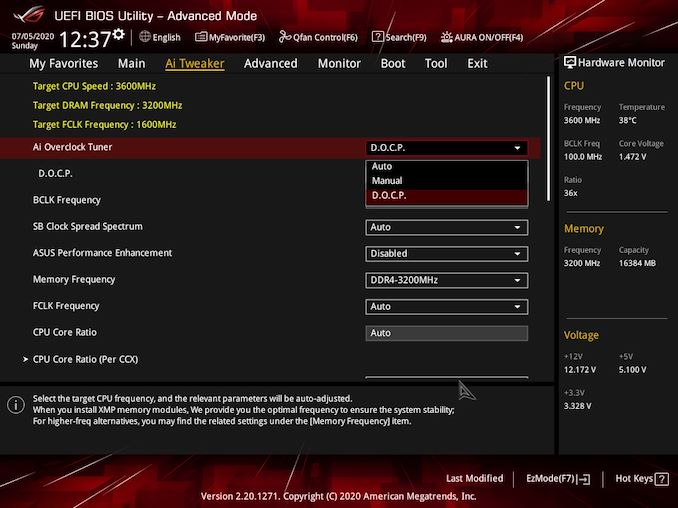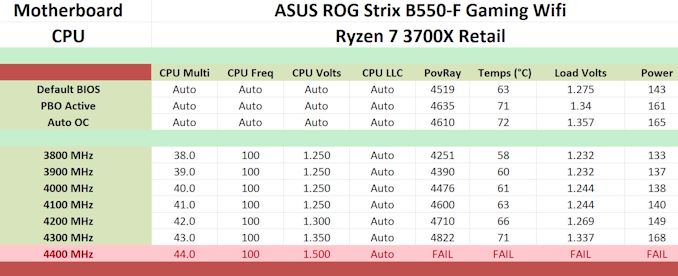The ASUS ROG Strix B550-F Gaming Wi-Fi Motherboard Review: Premium Value
by Gavin Bonshor on July 22, 2020 9:00 AM EST- Posted in
- Motherboards
- AMD
- Asus
- ROG
- AM4
- Strix
- Ryzen 3000
- Ryzen 3700X
- B550
- B550-F
Overclocking Ryzen 3000
Experience with the ASUS ROG Strix B550-F Gaming Wi-Fi
AMD's B550 series models allow users to overclock both the memory and processor in the same way as its X570 series motherboards. While the B series models are generally cheaper and feature lower-cost componentry, AMD's B550 is a clear exception to this rule and it has created a lot of fanfare across the internet forums. Ryzen 3000 does run warmer than the previous 2000 series of processors, even more so when they are pushed beyond default settings. Users looking to overclock Ryzen 3000 regardless of the motherboard, good quality and adequate cooling is a must-have.
The ASUS Republic of Gamers firmware is very easy to navigate and includes all of the necessary settings and options to overclock both the processor and memory. All of the relevant settings for overclocking can be found under the AI Tweaker menu, which includes a wide variety of CPU options including CPU frequency, voltages and power delivery settings. The CPU ratio can be adjusted in 100 MHz increments, with options for AMD's Precision Boost Overdrive function. Overclocking the processor can be done simply by changing the CPU Ratio and CPU VCore voltage, although more experienced overclockers will find plenty of options including Loadline Calibration settings and VRM power options which can enhance overclocks, especially when going above and beyond the recommended settings. This includes plenty of tweakable options for sub-zero overclockers.
For memory, users can simply enable XMP 2.0 profiles which ASUS calls DOCP on its AM4 based models. There's also a wide variety of settings that can be customized including DRAM voltage, and a large swathe of memory latency settings. For squeezing out extra MHz on both the memory and CPU, users can adjust the BCLK frequency, but doing it wrong or slapdash can result in instability, so it's easier to stick to the core/memory frequency and primary voltage settings. AMD recommends users use DDR4-3600 with the FCLK set to 1800 MHz for optimal performance.
Overclocking Methodology
Our standard overclocking methodology is as follows. We select the automatic overclock options and test for stability with POV-Ray and OCCT to simulate high-end workloads. These stability tests aim to catch any immediate causes for memory or CPU errors.
For manual overclocks, based on the information gathered from the previous testing, starts off at a nominal voltage and CPU multiplier, and the multiplier is increased until the stability tests are failed. The CPU voltage is increased gradually until the stability tests are passed, and the process repeated until the motherboard reduces the multiplier automatically (due to safety protocol) or the CPU temperature reaches a stupidly high level (105ºC+). Our testbed is not in a case, which should push overclocks higher with fresher (cooler) air.
We overclock with the Ryzen 7 3700X, for consistency with our previous overclocking tests.
Overclocking Results
Our experience with overclocking the ASUS ROG Strix B550-F Gaming Wi-Fi was a pleasant one and it performed very well in our overclock testing. Despite lacking any form of overclocking presets, there is the option to enable or disable AMD's Precision Boost Overdrive. With it enabled, we managed to squeeze a little bit of extra performance from our Ryzen 7 3700X at default settings, although it did come at the cost of extra heat and power. ASUS also includes and Auto OC function, but this didn't prove as efficient, with little in the way of performance gains over the stock settings.
Overclocking our Ryzen 7 3700X from 3.8 to 4.3 GHz was done without issue, and 4.3 GHz is the maximum stable overclock we've able to achieve on any board, including some of the most premium X570 models. Throughout the different frequency, the B550-F Gaming Wi-Fi had good levels of VDroop and performance in our POV-Ray benchmark consistently went up as we increased the frequency by 100 MHz each time.












40 Comments
View All Comments
Death666Angel - Wednesday, July 22, 2020 - link
So, single players games aren't a thing anymore? I game, but I don't play multiplayer modes or games.ZipSpeed - Wednesday, July 22, 2020 - link
I dunno, I'm not a competitive gamer by any means and I've been playing online via Wi-Fi for years with no issue. Maybe I'm just less sensitive to the variation because I honestly can't tell the difference wired and wireless.PeachNCream - Wednesday, July 22, 2020 - link
I haven't noticed a substantial difference, but there is a lot of hair splitting going on out there and it is well supported by marketing departments at hardware companies that want to land sales from people. Higher refresh rates, faster mouse polling, overclocking to gain like 2% more performance, Killer NICs that claim to give your game's data packets priority over other packets and so forth all appeal to people that feel like buying all of those things will make them more competitive so they get to teabag someone's corpse more often and feel proud of themselves when their only accomplishment in life is being at or around the top of a leader board. It's sad, but male competitiveness easy to exploit because the individual experiencing it is typically blind to it and will not think rationally about it. Why else to obese men purchase large pickup trucks or glitter bomb glowing computers except to feel empowered in some small way? The WiFi versus wired ethernet thing is just one more way to proclaim you feel superior to someone that doesn't care enough to throw a twisted pair cable across a room or two.CardiWAP - Tuesday, August 11, 2020 - link
Absolute rubbish.Play any fighting game and you can tell right away when somebody is on Wi-Fi. Same thing in shooters.
Wi-Fi really is awful for anything requiring quick action.
Fighting games are based on frames and you have to be aware at every single moment of the frame data of moves.
Any added latency, jitter or any hiccup and the things you thought should have worked (and would have worked in a low latency wired connection) doesn't anymore. You drop a combo, you fail to punish a move, you fail to party and you die.
This particular example that is familiar to me can be extended to any online game requiring quick action, reflexes and constant known data and behavior.
Not using WiFi in these online games is not about anything you've described. It's just about having the best online experience - meaning one closest to offline. And you obviously wreak havoc playing on WiFi it might also be a question of respect for people playing with/against you.
The part about high refresh rate monitor is as misinformed and far-fetched as the Wi-Fi one.
You simply need to drag a simple window in your favourite OS and switch between 60Hz and 144Hz to understand the wonders of the smoothness in high framerate gaming.
Moreover, the switch to flat screen panels really was in some instances a regression that is somewhat mitigated with high refresh rate panels (in the blur department).
Overclocking has been a core part of PC gaming for decades so I won't even bother going further than this.
You might have a leg to stand on regarding Killer NICs and their drivers but they don't jack up the price of the motherboards they are in so it doesn't matter anyway.
MrVibrato - Wednesday, July 22, 2020 - link
I didn't know that you spell ISP like "WiFI" in your corner of the world. ;-PGastec - Sunday, January 3, 2021 - link
WiFi "kills" more than just gaming performances, it's slower than Ethernet cable connection for everything. A WiFi connection between the computer and the router is useful in certain situations but we can't deny that there is a consistent propaganda campaign to convince the consumers to switch from Ethernet to wireless connections, for a good price of course. The more you buy, the more we profit, after all! :)DanNeely - Wednesday, July 22, 2020 - link
"USB 3.0 (5 Gbps) 2 x Type-A Header (2 x ports)"Type A headers are 2 ports, each so this should either be 1x header, or 4x ports.
Ryan Smith - Wednesday, July 22, 2020 - link
Thanks Dan. That's indeed 1 header.mooninite - Wednesday, July 22, 2020 - link
What about a test network performance? The I225-V has two bad revisions (v1 & v2) and there is no known way to know what version you will buy. A benchmark could confirm it.DanNeely - Wednesday, July 22, 2020 - link
If they're not making it explicit in the specsheet any test Gavin did would be of limited value since there would be nothing stopping Asus from having a silicon lottery where not all production runs use the same version of the controller.